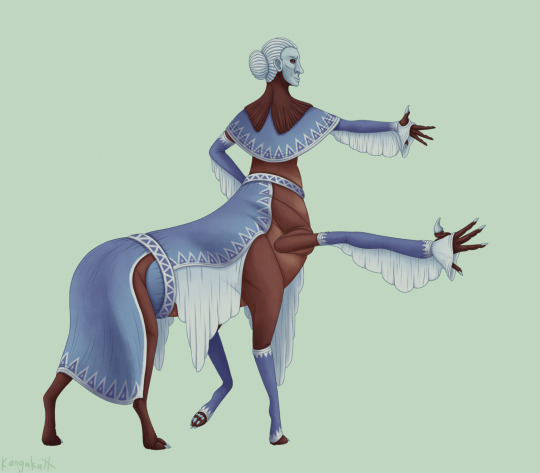#I’m so used to bots trawling tags on Instagram
Text
A human/Azi lana hybrid.

Genetic modification in the ULE is… complicated. It’s way easier to simulate projected changes in a plant or a dog, for instance, than in the human brain. And if, despite the computer simulation, you get it wrong, well… if it’s a plant or a dog, you can just try again.
When it comes to sapient species- humans, Azi lana, and such- it’s much easier to do something like replacing body hair with feathers, or adding a tail, or lengthening arms, than to completely overhaul bodyplan and anatomy. So while the former is common in some places, the latter almost can’t be done.
But while mere sapients cannot grasp the complexity of their own bodies and minds, they are not the only intelligent beings in the universe. Superintelligents are vast minds with the power to understand and grasp every aspect of the sapient brain. Though many are unconcerned with the happenings of mortals, a few have helped sapients along their way.
One superintelligence, Anwarth, has gone above and beyond for local sapient nations. Their portfolio includes blueprints for sapient robots, a brain implant that acts as a universal translator, and perhaps their crowning achievement: an algorithm that can create a functional person from DNA samples of entirely separate sapient species.
The GECCAI algorithm, as easy to use and consistently successful as it is, is the relied-upon method for creating hybrid offspring between two alien parents. Though all hybrids are created to do the basics- eat, move, communicate, etc- the different biologies of their alien parents means their own anatomy can be quite exotic. Both this and the inherent sterility of hybrids has sociological implications for their way of life.
More about the Azi lana | more about hybrids in the ULE | more about the universe
#ulexemp#sci-fi ice elemental vibes#speculative biology#worldbuilding#speculative evolution#science fiction#scifi#spec evo#xenobiology#worldbuilding art#I’m so used to bots trawling tags on Instagram#I always forget to tag my tumblr posts with art related things#so here goes#art#digital art#my art#artists on tumblr
25 notes
·
View notes